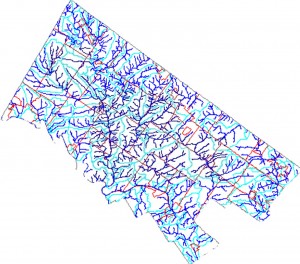Watershed Management
-
- Pennsylvania Clean Water Academy has courses available to the public which may be accessed by clicking here.
What is a watershed?
A watershed is simply an area of land that drains to a particular water body. Water flows across the land, underground, and through storm sewer systems to reach our streams and rivers. Each stream has its own watershed draining to it, and all the waterways in Montgomery County lead to the Delaware Bay, so we all live in the larger Delaware River Watershed.
The way watersheds work is what you do to the land, you do to the water. Pollution from the land washes into our waterways and eventually ends up in the Delaware River and Atlantic Ocean.
Picture 1: Montgomery County Streams
What is your watershed address?
Everyone lives in a local watershed. Do you know which one you live in? Check out the maps of Pennsylvania and Montgomery County to figure out your watershed address.
How to protect your watershed
Watersheds are natural systems that link the land and water resources, and the living organisms, including people, within its boundaries. How we live on the land affects the quality and quantity of water within the watershed. Want to join a local watershed group? Visit the Pennsylvania Directory of Watershed Organizations to find one near you.
Here are some steps you can take at home to protect water quality.
Streambank Stabilization
Stabilizing streambanks with shrubs and trees filters stormwater runoff and minimizes soil erosion, while providing an excellent habitat for wildlife. Want to get involved in local streambank restoration efforts? Visit the Montgomery County TreeVitalize page for more information on local projects.
Bioengineering techniques use a combination of structural and biological methods to stabilize streambanks, providing a more natural-looking solution than traditional rip-rap and concrete structures. Native plant materials are incorporated into the natural restoration. The species used are adaptable to living in riparian habitats. These plants include herbaceous species such as sedges and rushes, as well as woody species like dogwoods and willows. The species have fibrous root systems that can hold the soil of the streambanks in place. There are many techniques using native plants as stabilizing materials. If installed and monitored correctly, bioengineering can be a successful, less expensive, environmentally sensitive approach to preventing soil erosion and stabilizing streambanks. For more information on bioengineering techniques, please visit the Natural Resource Conservation Service’s Stream Restoration Manual.
For a simple guide to understanding what DEP requires when working in or along a stream, download the Guidelines for Maintaining Streams In Your Community booklet.
Invasive Species
An invasive species is one that has been introduced from an outside ecosystem and aggressively dominates a landscape, minimizing biodiversity. Invasive plants grow aggressively, spread, and displace other plants. Invasive plant infestations can be extremely expensive to control, as well as environmentally destructive. For more information on PA invasive species identification and control, visit the Department of Conservation and Natural Resource’s Invasive Exotic Plant Tutorial.
Native Landscaping
An area maintained as a meadow versus conventional lawn has the ability to recharge 16 times more rainfall into the ground. Native plants have deeper root systems than turf grass. They thrive in local habitats, so they require less maintenance and fertilizers to survive. For more information on Native Plants, visit the Department of Conservation and Natural Resource’s “Landscaping with Native Plants in Pennsylvania” publication.
Growing Greener
This grant process puts millions of dollars in state funding into the hands of local communities to protect their watersheds from nonpoint sources of pollution. For more information on Growing Greener and other DEP grants, please visit the Department of Environmental Protection’s Grant website.
Pollution Sources
Sources of stream pollution include:
1) Point Sources – easily identified sources where pollutants are discharged into a waterway. These sites are permitted by the state for a specified discharge volume.
2) Nonpoint Sources – pollutants that are picked up when runoff flows across the landscape. These pollutants include everything from fertilizers from lawns and fields, sediment from construction sites, salts from icy roads, and gasoline and oils from parking lots. Non-point Source pollution makes up the majority of the pollutant load on our waterways.
Links to Local Watershed Organizations
Click here for a list of local Watershed Organizations.
For more information on any of these topics, contact:
Brian Vadino
Watershed Specialist
(610) 489-4506 (ext. 15 )
